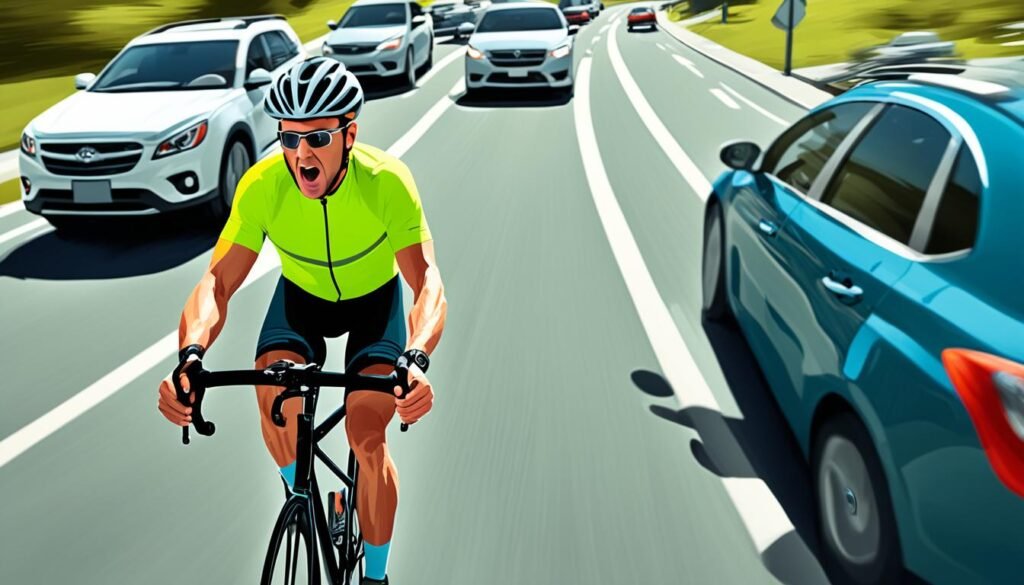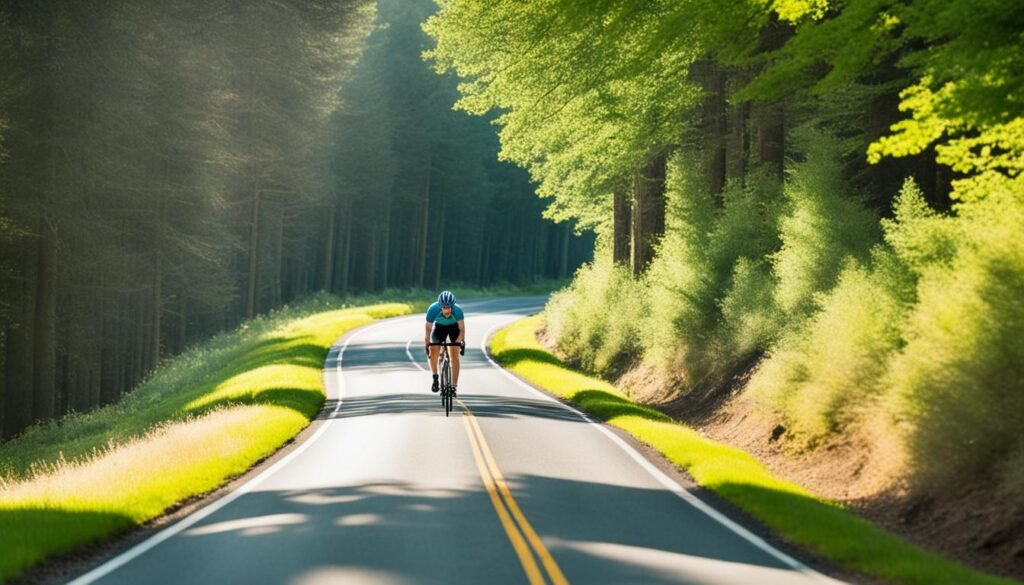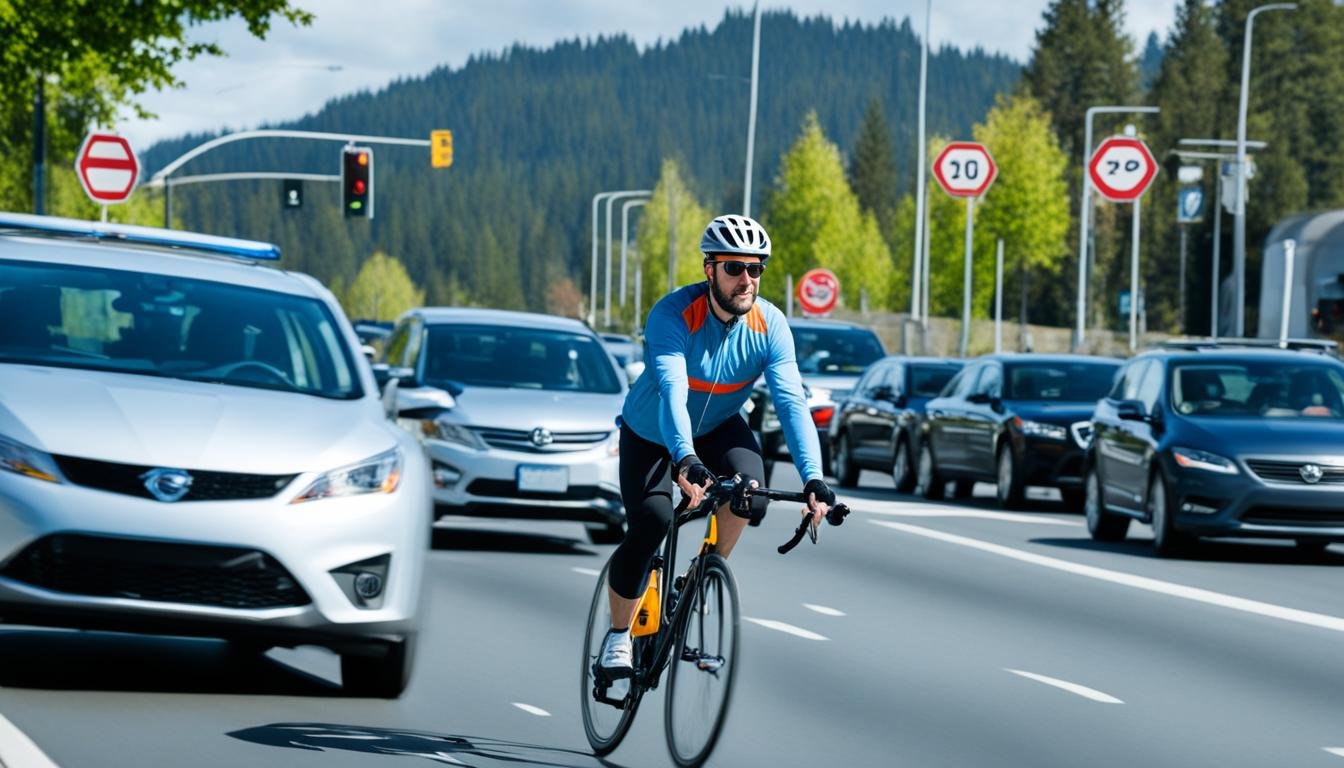Did you know aggressive driving causes more than half of all cyclist road rage incidents?
Every year, countless cyclists deal with the risks of aggressive driving. Being ready with the right strategies is key for a cyclist’s safety.
In this article, we share six tips to keep you safe on the road. These tips cover everything from de-escalating situations to collecting evidence. They will help you protect yourself and make cycling safer for everyone.
Key Takeaways:
- Stopping road rage is vital for keeping cyclists safe.
- Cyclists can stop tense situations by staying calm and composed.
- Using a bike’s agility lets cyclists escape tight spots safely when faced with aggression.
- It’s important to defend yourself, but stay within the law.
- Gathering evidence, like the driver’s license plate and noting injuries, is key for insurance and legal matters.
De-escalate the Situation
When dealing with aggressive drivers, keeping cool is key. Getting angry or arguing can make things worse, like insurance troubles. The main goal is to stay calm and put your safety first.
Even if you think you’re right, don’t fight with the driver. Arguing can make the danger grow. Instead, breathe deeply and walk away. Look for a safe spot to think and plan your next move.
Staying calm lets you gather important info for court or insurance. Write down the driver’s license number and any witness names. These facts can back you up if you talk to the police or your insurance.
“Staying calm in confronting moments is key, as it allows you to gather relevant information and protect your own safety.” – John Smith, cycling safety expert
Steps to De-escalate:
- Take a deep breath and compose yourself.
- Avoid engaging in arguments or trading insults with the aggressive driver.
- Remove yourself from the situation and find a safe place nearby.
- Record the driver’s license plate number and take note of any witnesses.
De-escalating not only keeps you safe but also helps solve any legal or insurance issues. Remember, staying calm with aggressive drivers is vital to protect yourself and keep the peace on the roads.

Keep Your Cool
When you meet an aggressive driver, staying calm is key. Don’t react with anger or argue back. It’s better to find a safe spot to cool off and think.
Being calm helps you remember important details. Try to recall the aggressive driver’s license plate and car type. These facts can help if you need to talk to police or your insurance.
Look for people who saw what happened. They can back up your story. Make sure to get their contact details.
“Staying calm in the face of aggression allows you to maintain control of the situation and prioritize your safety.” – Cycling Safety Expert
Don’t forget to contact the police and file a report. This report is an official record. It’s very helpful when dealing with insurance or in court. Always put your safety first in aggressive situations.

Use the Bicycle’s Mobility to Your Advantage
Bicycles are great for their speed and flexibility. This makes them perfect for avoiding problems with angry drivers. You can use your bike’s quick movements to slip through tight spots and reach places cars can’t go. This ability is key to staying safe and getting help when dealing with aggressive drivers.
If an angry driver is chasing you, your bike can help you get away fast. You can zip through narrow alleys and passageways that cars can’t enter. This skill lets you find safe spots quickly, away from danger. It also helps you find people who might have seen what happened, which can help if you need to take legal steps.
When it’s hard to escape an aggressive driver chasing you, try to stay calm. Use your bike’s speed to avoid making things worse. Look around quickly to find a safe spot or a public place where you can get help or hide.
It’s very important to put your safety first when you’re in danger. If you need help right away, call 911 or local emergency services. They can give you advice and step in to keep you safe.
Your bike’s speed and ability to move quickly are your best defenses against aggressive drivers. By knowing how to use these bike benefits, you can escape tight spots, find safe places, and get help when you need it.
Where to find Safe Places
Knowing where to find safety is crucial when you’re dealing with an aggressive driver. Look for:
- Parks or outdoor recreational areas
- Supermarkets or shopping centers
- Gas stations or convenience stores
- Police stations or other law enforcement agencies
- Public transportation hubs
Keeping a mental list of these safe spots in your area can help you act quickly in dangerous situations.
| Safe Places | Description |
|---|---|
| Parks or outdoor recreational areas | These public spaces offer open areas where you can find help and potential witnesses. They’re usually full of people, which can scare off aggressors. |
| Supermarkets or shopping centers | These big stores have security and cameras. They’re a secure place to wait or find help. |
| Gas stations or convenience stores | Staff at these places can help, and they often have cameras to catch aggressive behavior. |
| Police stations or other law enforcement agencies | Going to a police station can keep you safe and get you immediate help if you’re in danger. |
| Public transportation hubs | Bus or train stations are usually crowded and well-lit. They often have security, making them safe places to get help. |
Defend Yourself Reasonably
Avoiding fights with aggressive drivers is key, but you can defend yourself if attacked or threatened. Your actions must be reasonable and legal. Judges and juries will look closely at what you do and say, so make sure your self-defense is justified and lawful.
Here are some tips for when you’re in a scary situation:
- Check the danger level: See if there’s a real risk of getting hurt and if you can calm things down instead.
- Use the right amount of force: Protect yourself but don’t go overboard. Only do what’s necessary to stop the threat.
- Think about self-defense moves: If you must fight back, use techniques that defend you without causing unnecessary harm. Training in martial arts or self-defense can really help here.
Remember, self-defense is for critical moments, not for starting fights or getting even. Use it only as a last choice, when there’s no other way out and you’re in immediate danger. Always think of your safety first and stay within the law.
Gather as Much Evidence as You Can
Gathering evidence is very important when you need to protect your rights after an incident with an aggressive driver. It helps you build a strong case. To get fair compensation for your injuries and damages, you need as much info as possible. Here are some key steps to take:
- Collecting Evidence: After an incident, gather evidence like the driver’s license plate number, their car’s look, and any unique features. This info helps find who was responsible. Also, take pictures of the scene. This should include your bike’s damage, any injuries, and the area around the accident.
- Documenting Injuries: It’s crucial to see a doctor right away, even if you think your injuries are minor. Your medical records are key evidence for your injury claims. Keep track of all your medical visits, what the doctors say, and how much your treatment costs.
- Having Witnesses: If people saw the accident, get their contact info before they go. What they saw can really support your case. If you have a camera on your helmet, check the footage. It might have more evidence to help tell your side of the story.
By carefully collecting evidence, recording your injuries, and having witnesses, you make your legal case stronger. Remember, the more evidence you collect, the better your chances.
| Evidence to Collect | Importance |
|---|---|
| Driver’s license plate number | Allows for identification of the responsible party |
| Vehicle description and identifying features | Aids in determining the driver involved in the incident |
| Photographs of the scene | Provides visual evidence of the incident and any damage sustained |
| Photographs of injuries | Supports personal injury claims and the extent of harm suffered |
| Contact information of witnesses | Enables follow-up interviews and gathering of witness testimonies |
| Helmet-mounted camera footage | Additional video evidence that can strengthen your case |
Conclusion
Cyclists play a key role in keeping themselves safe on the roads. By following six important steps, cyclists can avoid harm from aggressive drivers. Staying calm and using their bikes’ agility help a lot too.
But that’s not all. Cyclists should also gather evidence and know their legal rights. This is crucial for insurance claims or seeking compensation. By doing all these, cyclists help make roads safer for everyone. They set an example for protecting cyclists everywhere.
FAQ
How can I de-escalate a situation with an aggressive driver?
Why is it important to stay calm when facing aggressive drivers?
How can I use my bicycle’s mobility to my advantage?
Can I defend myself against an aggressive driver?
Why is gathering evidence important when facing aggressive drivers?
Source Links
- https://www.rmdlaw.com/personal-injury-blog/how-to-protect-yourself-from-aggressive-drivers-while-cycling-in-traffic/
- https://www.thefloridalawgroup.com/news-resources/the-ultimate-bicycle-safety-checklist-8-tips-for-cyclists-to-reduce-their-risk-of-being-involved-in-a-traffic-accident/
- https://socalcycling.com/2024/01/10/why-bicycle-accidents-occur-and-how-to-protect-yourself/

